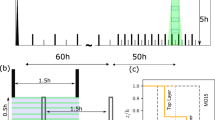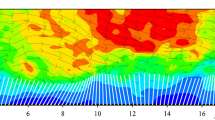Abstract
The effect of canopy heterogeneity on mean and turbulent transport processes is studied using a scaled wind-tunnel model of a vineyard canopy with gap spacings of one, two, and three canopy heights. A row-normal freestream velocity component is applied to each canopy configuration and spatial distributions of velocity across a streamwise-vertical plane centred around a single canopy gap are measured using particle imaging velocimetry. Mean flow features including an updraft in the centre of the canopy followed by a descent and recirculation just upstream of the downstream row are observed to decrease in size and magnitude for larger canopy gaps. Turbulence in the canopy sublayer (CSL) is dominated by a growing mixing layer that originates at the top of the upstream row and consumes the underlying weak more isotropic turbulence. The mixing layer’s rate of growth into the CSL decreases as the canopy gap widens, but not enough to offset the increased downstream distance. The vertical extent of the mixing layer into the canopy before being impeded by the downstream row is the main factor that determines horizontal heterogeneity of turbulence in the canopy. An analysis of the Reynolds-averaged turbulence-kinetic-energy budget points to shear production being the main source of turbulence near the canopy top, while turbulent transport is responsible for the growth of the mixing layer down into the CSL.










Similar content being viewed by others
References
Addepalli B, Pardyjak ER (2013) Investigation of the flow structure in step-up street canyons-mean flow and turbulence statistics. Boundary-Layer Meteorol 148(1):133–155
Bai K, Meneveau C, Katz J (2012) Near-wake turbulent flow structure and mixing length downstream of a fractal tree. Boundary-Layer Meteorol 143(2):285–308
Bai K, Katz J, Meneveau C (2015) Turbulent flow structure inside a canopy with complex multi-scale elements. Boundary-Layer Meteorol 155(3):435–457
Bailey BN, Stoll R (2013) Turbulence in sparse, organized vegetative canopies: a large-eddy simulation study. Boundary-Layer Meteorol 147(3):369–400
Bailey BN, Stoll R (2016) The creation and evolution of coherent structures in plant canopy flows and their role in turbulent transport. J Fluid Mech 789:425–460
Blackman K, Perret L, Calmet I, Rivet C (2017) Turbulent kinetic energy budget in the boundary layer developing over an urban-like rough wall using PIV. Phys Fluids 29(8):085113
Böhm M, Finnigan JJ, Raupach MR, Hughes D (2013) Turbulence structure within and above a canopy of bluff elements. Boundary-Layer Meteorol 146(3):393–419
Britter R, Hanna S (2003) Flow and dispersion in urban areas. Annu Rev Fluid Mech 35(1):469–496
Brunet Y, Finnigan JJ, Raupach MR (1994) A wind tunnel study of air flow in waving wheat: single-point velocity statistics. Boundary-Layer Meteorol 70(1):95–132
Brunet Y (2020) Turbulent flow in plant canopies: Historical perspective and overview. Boundary-Layer Meteorol 177(2):315–364
Cellier P, Brunet Y (1992) Flux-gradient relationships above tall plant canopies. Agric Meteor 58(1–2):93–117
Chahine A, Dupont S, Sinfort C, Brunet Y (2014) Wind-flow dynamics over a vineyard. Boundary-Layer Meteorol 151(3):557–577
Christen A, Rotach MW, Vogt R (2009) The budget of turbulent kinetic energy in the urban roughness sublayer. Boundary-Layer Meteorol 131(2):193–222
Cionco RM (1965) A mathematical model for air flow in a vegetative canopy. J Appl Meteor Climatol 4(4):517–522
Cionco RM (1972) A wind-profile index for canopy flow. Boundary-Layer Meteorol 3(2):255–263
Dry PR (2000) Canopy management for fruitfulness. Aust J Grape Wine Res 6(2):109–115
Dupont S, Brunet Y (2008) Edge flow and canopy structure: a large-eddy simulation study. Boundary-Layer Meteorol 126(1):51–71
Everard KA, Oldroyd HJ, Christen A (2020) Turbulent heat and momentum exchange in nocturnal drainage flow through a sloped vineyard. Boundary-Layer Meteorol 175(1):1–23
Finnigan J (2000) Turbulence in plant canopies. Annu Rev Fluid Mech 32(1):519–571
Garratt J (1980) Surface influence upon vertical profiles in the atmospheric near-surface layer. Quart J Roy Meteor Soc 106(450):803–819
Giometto M, Christen A, Meneveau C, Fang J, Krafczyk M, Parlange M (2016) Spatial characteristics of roughness sublayer mean flow and turbulence over a realistic urban surface. Boundary-Layer Meteorol 160(3):425–452
Hamed AM, Sadowski MJ, Nepf HM, Chamorro LP (2017) Impact of height heterogeneity on canopy turbulence. J Fluid Mech 813:1176–1196
Hamed AM, Peterlein AM, Speck I (2020) Characteristics of the turbulent flow within short canopy gaps. Phys Rev Fluids 5(12):123–801
Harman IN, Finnigan JJ (2007) A simple unified theory for flow in the canopy and roughness sublayer. Boundary-Layer Meteorol 123(1):339–363
Harman IN, Böhm M, Finnigan JJ, Hughes D (2016) Spatial variability of the flow and turbulence within a model canopy. Boundary-Layer Meteorol 160(3):375–396
Hayati AN, Stoll R, Pardyjak ER, Harman T, Kim JJ (2019) Comparative metrics for computational approaches in non-uniform street-canyon flows. Build Environ 158:16–27
Hong J, Katz J, Schultz MP (2011) Near-wall turbulence statistics and flow structures over three-dimensional roughness in a turbulent channel flow. J Fluid Mech 667:1–37
Hussain M, Lee BE (1980) A wind tunnel study of the mean pressure forces acting on large groups of low-rise buildings. J Wind Eng Ind Aerodyn 6(3–4):207–225
Johnson LF, Roczen DE, Youkhana SK, Nemani RR, Bosch DF (2003) Mapping vineyard leaf area with multispectral satellite imagery. Comput Electron Agric 38:33–44
Judd MJ, Raupach MR, Finnigan JJ (1996) A wind tunnel study of turbulent flow around single and multiple windbreaks, part I: Velocity fields. Boundary-Layer Meteorol 80(1–2):127–165
Kaimal JC, Finnigan JJ (1994) Atmospheric boundary layer flows: their structure and measurement. Oxford University Press, Cambridge
Karra S, Malki-Epshtein L, Neophytou MKA (2017) Air flow and pollution in a real, heterogeneous urban street canyon: A field and laboratory study. Atmos Environ 165:370–384
Laws EM, Livesey JL (1978) Flow through screens. Annu Rev Fluid Mech 10(1):247–266
Lee JP, Lee SJ (2012) PIV analysis on the shelter effect of a bank of real fir trees. J Wind Eng Ind Aerodyn 110:40–49
LeMone MA, Angevine WM, Bretherton CS, Chen F, Dudhia J, Fedorovich E, Katsaros KB, Lenschow DH, Mahrt L, Patton EG et al (2019) 100 years of progress in boundary layer meteorology. Meteor Monogr 59:9.1-9.85
Margairaz F, Eshagh H, Hayati AN, Pardyjak ER, Stoll R (2022) Development and evaluation of an isolated-tree flow model for neutral-stability conditions. Urban Clim. https://doi.org/10.1016/j.uclim.2022.101083
Maruyama T (2008) Large eddy simulation of turbulent flow around a windbreak. J Wind Eng Ind Aerodyn 96(10–11):1998–2006
Melling A (1997) Tracer particles and seeding for particle image velocimetry. Meas Sci Technol 8(12):1406–1416
Miller NE, Beresh SJ (2021) Using particle image velocimetry to determine turbulence model parameters. Am Inst Aeronaut Astronaut 59(3):842–854
Miller NE, Stoll R, Mahaffee WF, Pardyjak ER (2017) Mean and turbulent flow statistics in a trellised agricultural canopy. Boundary-Layer Meteorol 165(1):113–143
Moltchanov S, Bohbot-Raviv Y, Shavit U (2011) Dispersive stresses at the canopy upstream edge. Boundary-Layer Meteorol 139(2):333–351
Nakaya K, Suzuki C, Kobayashi T, Ikeda H, Yasuike S (2007) Spatial averaging effect on local flux measurement using a displaced-beam small aperture scintillometer above the forest canopy. Agric Meteor 145(1–2):97–109
Nebenführ B, Davidson L (2015) Large-eddy simulation study of thermally stratified canopy flow. Boundary-Layer Meteorol 156(2):253–276
Novak MD, Warland JS, Orchansky AL, Ketler R, Green S (2000) Wind tunnel and field measurements of turbulent flow in forests. part I: uniformly thinned stands. Boundary-Layer Meteorol 95(3):457–495
Park SJ, Kim JJ, Choi W, Kim ER, Song CK, Pardyjak ER (2020) Flow characteristics around step-up street canyons with various building aspect ratios. Boundary-Layer Meteorol 174(3):411–431
Patton EG, Shaw RH, Judd MJ, Raupach MR (1998) Large-eddy simulation of windbreak flow. Boundary-Layer Meteorol 87(2):275–307
Poëtte C, Gardiner B, Dupont S, Harman I, Böhm M, Finnigan J, Hughes D, Brunet Y (2017) The impact of landscape fragmentation on atmospheric flow: a wind-tunnel study. Boundary-Layer Meteorol 163(3):393–421
Poggi D, Porporato A, Ridolfi L, Albertson J, Katul G (2004) The effect of vegetation density on canopy sub-layer turbulence. Boundary-Layer Meteorol 111(3):565–587
Pope SB (2000) Turbulent Flows. Cambridge University Press, Cambridge
Raupach MR, Shaw RH (1982) Averaging procedures for flow within vegetation canopies. Boundary-Layer Meteorol 22(1):79–90
Raupach MR, Finnigan JJ, Brunei Y (1996) Coherent eddies and turbulence in vegetation canopies: the mixing-layer analogy. Boundary-Layer Meteorol 78(3–4):351–382
Shnapp R, Shapira E, Peri D, Bohbot-Raviv Y, Fattal E, Liberzon A (2019) Extended 3D-PTV for direct measurements of lagrangian statistics of canopy turbulence in a wind tunnel. Sci Rep 9(1):1–13
Speckart SO, Pardyjak ER (2014) A method for rapidly computing windbreak flow field variables. J Wind Eng Ind Aerodyn 132:101–108
Stoll R, Gibbs JA, Salesky ST, Anderson W, Calaf M (2020) Large-eddy simulation of the atmospheric boundary layer. Boundary-Layer Meteorol 177(2):1–41
Stull RB (1988) An introduction to boundary layer meteorology. Springer, Berlin
Van Hout R, Zhu W, Luznik L, Katz J, Kleissl J, Parlange MB (2007) PIV measurements in the atmospheric boundary layer within and above a mature corn canopy. part I: statistics and energy flux. J Atmos Sci 64(8):2805–2824
Yue W, Meneveau C, Parlange MB, Zhu W, Kang HS, Katz J (2008) Turbulent kinetic energy budgets in a model canopy: comparisons between les and wind-tunnel experiments. Environ Fluid Mech 8(1):73–95
Zhu W, van Hout R, Luznik L, Kang HS, Katz J, Meneveau C (2006) A comparison of PIV measurements of canopy turbulence performed in the field and in a wind tunnel model. Exp Fluids 41(2):309–318
Acknowledgements
This research was supported by the National Science Foundation through grants AGS-1255662 and AGS-1660367. Funding was also provided by the United States Department of Agriculture National Institute for Food and Agriculture Specialty Crop Research Initiative Award No. 2018-03375 and the United States Department of Agriculture Agricultural Research Service through Research Support Agreement 58-2072-0-036.
Author information
Authors and Affiliations
Corresponding author
Additional information
Publisher's Note
Springer Nature remains neutral with regard to jurisdictional claims in published maps and institutional affiliations.
Supplementary Information
Below is the link to the electronic supplementary material.
Rights and permissions
About this article
Cite this article
Torkelson, G., Price, T.A. & Stoll, R. Momentum and Turbulent Transport in Sparse, Organized Vegetative Canopies. Boundary-Layer Meteorol 184, 1–24 (2022). https://doi.org/10.1007/s10546-022-00698-6
Received:
Accepted:
Published:
Issue Date:
DOI: https://doi.org/10.1007/s10546-022-00698-6




